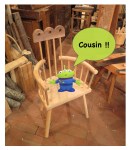The Revival of Skilled Hand-Work –

In New England a good workman is described as a “Master-hand at his trade.” Within the past few years a new and superior workman has appeared who is his own designer, skilled worker and dealer—in brief, his own employer. There are women also who are designers and workers and are their own saleswomen.
The upper West-side apartment district of New York may not appear to be the best place to find the shop of a Master-hand. A few steps from prosaic Columbus Avenue, on One hundred and Fourth Street, lead to a small brick dwelling. There is a high stoop and a large basement window and a few stone steps lead down to a lofty basement room having a fine north light.
Here at a table sits a young woman clad in a long check apron and busy with skilful fingers upon a mass of New Jersey clay. Slowly, inch by inch, the mass grows up into the form of a beautiful vase. She has the usual sculptor’s tools, nothing more—not even a potter’s wheel. She has had a sculptor’s training, is an art student and practical designer and potter.
About the room on shelves are black terra-cotta vases of every form and size from little flower bowls up to great garden vases. All are of her own design and workmanship. Everything is her own handiwork except the firing, the smaller vases being fired at a Harlem pottery, and the larger vases fired at Perth Amboy.
Every vase is for sale and many more have been sold and distributed. At intervals cards are sent out for a studio reception sale and the little room is crowded for hours and empty when the last guest carries off the last vase. The young woman’s mother assists in the little shop and this-makes the whole plant, a basement room, two Master-hands and some Jersey clay.
East Twenty-Third Street is never lovely and it comes with a sort of pleasant surprise to take an elevator to the top floor and escape from the dreary street into the silence and reposeful peace of a charming little studio-home. A young woman welcomes, in soft Southern speech, to her home and her workshop. She begs to be excused from mere social forms. She can talk and work, and sits before a great wooden chest and takes up her wood-carving tools, and while she talks the beautiful foliage seems to grow under her skilful fingers.
With enthusiasm she discourses upon the wood and the design of the chest. The design is her own and the only thing she did not do was the actual putting together of the chest. Why should she waste her valuable time on work any carpenter can do? All else, design, carving, fire etching, coloring, ornaments, handles, hinges and locks are her own work except the heavy forging of the handles and clasps.
She is the Master-hand of the whole job and when finished it will be a beautiful chest, fit for the outfit of a bride. In the next room another girl is at work upon another beautiful chest. On the walls are mats and other useful things in leather, colored, tooled and fire-etched. The place is a shop and it is also salesroom and the home of the Master-hands.
Not far away, on East Twentieth Street, is another still larger shop. Here two women, Master-hands in copper, design and make copper vessels and utensils for parlor and kitchen. Strong, well made and beautiful, the things give a new dignity to the art of the coppersmith. On the walls are fine fabrics stenciled in colors in novel and attractive designs. On the tables are mats and useful things for the desk in tooled and colored leather. The Master-hands do everything from the designing to the making of the finished products and the studio workshops are combined workrooms and salesrooms.
The top floor of a first-class apartment house overlooking Riverside Drive is not the place where we might expect to find a first-rate Master-hand busy with pencil and tools. She sits by a window giving a splendid view of the Hudson, at work developing her own designs upon leather, using novel tools invented in her own shop, and talking with honest pride of her work and her success as a Master-hand.
If these new working women, Master-hands in their trades, were alone they might merely pass as dreadful examples of the danger of trying to be eccentric. If there were no other shops but these four to be found they would certainly not be worthy of any special mention. They are here described because they are types of many shops scattered all over the country and because they are in convenient reach of any one in New York interested in a new phase of industry and labor.
The Master-hands have opened shop in at least twelve of our cities and towns. They now design, make and sell furniture, ironwork, copper and brass, lace, rugs, carpets, violins, tiles, pottery, fine chinaware, leather work, chests, jewelry, silverware, buckles, clasps and other enameled ornaments, baskets, woodenware, terra-cotta vases and architectural ornaments. Some of the shops print and bind books and others design and make stained-glass windows.
It is very difficult to say exactly how many men and women are thus employed in their own shops or are at work at home, either the whole or a part of the time. Good authorities place the number of regular shops where the makers are self-employed at about fifty, but as new shops are opened every month, particularly in small towns, it is safe to say that at least one hundred Master-hands are now earning a living in their own shops. Besides those who give the whole of their time to the work there must be at least two hundred other skilled workers who give a part of their time to these various handicrafts.
In nearly all the shops the Master-hands are also their own salesmen, but it did not take long for far-sighted dealers to see that the Master-hands were creating a new business. So we find in some of our larger cities stores more or less devoted to the exhibition and sale of the products of these new shops. There is one store of this kind in Boston and a most attractive store has been recently opened in New York for the sale of the beautiful products of these new shops. The Master-hands very quickly discovered that the studio is not the best place in which to sell the goods and sent their goods to the stores, greatly to their advantage, though all continue to exhibit and take orders in their little shops.
It is not easy to say how this new and promising business sprang into such sudden success. That it is successful is beyond question and, best of all, the demand for the goods thus made rapidly increases from month to month. In a certain way the business is the natural outcome of the work of the Exchange for Women’s Work. There are now eighty of these exchanges for the sale of work done by women. These exchanges began as places where embroidery, lace, cake bread, pickles, and other home-made things could be offered for sale. They give employment to many hundreds of women and distribute hundreds of thousands of dollars among the home workers every year, the New York Exchange distributing in 1900 $55,000.
A portion of these workers have become Master-hands, but the majority of the Master-hands sell their work through the dozen or more Arts and Crafts Societies, now established throughout the country. A few of the Master-hands sell only at their own shops and advertise their goods through the press. In one or two instances a number of workers have united and do their work in one shop and have one salesman for all their products. In several instances the shops are a part of larger plants making other things, a furniture shop and forge being attached to a printing and bookbinding concern.
In every instance the Master-hand, whether man or woman, is his or her own designer and makes the finished product wholly or in large part with hand tools only. All are highly trained designers and artisans and all must have more or less art education. The whole business is based upon hand work and it must be skilful, honest and inspired with real love of the work.
There can be no eight-hours-a-day business, for the worker, fired with a real love of the work, is greedy of every minute of daylight. He has no time for the folly of the saloon. He never watches the clock or slows up just before whistle time. There is no whistle on the new shop, no shop rules, no foreman, no time-keeper. The workman is boss and the boss is the worker. There are no wages, but profits. There is no employer, liable to fail or to die and throw the worker upon the streets; for the worker deals, either directly or through a store or society, with the public and the public is the universal paymaster and can never die or fail.
The buying public has evidently discovered the Master-hand. The useful, the practical and the cheap must be the products of the mill and factory. Machine-made things we must have and always will have, and it is fortunate indeed that machinery can and does supply many human wants at such low cost. With it all there remains a survival of the old mediæval love of the honest, hand-made thing.
We like to have and use the real hand-made, the thing that is wrought by skilled hands, inspired by a love of work and touched with the tool marks of the Master-hand. It is this love of the hand-made that has developed and sustained the new shops. The buyer will pay well for the unique thing, the one thing bearing the Master’s sign manual stamped upon the thing itself.
The public patronizes the Arts and Crafts Societies, because it believes that the things upon their shelves are the real things. It learns the value of personal trade-marks and it buys by the trade-mark rather than by the advice of the shopkeeper to whom the “just as good” is the only trick of his trade he knows. For the superior workman tired of the shop and factory, for the man who wants to work for the love of good work, the Master-hands are an example and an inspiration.
Charles Barnard
The World’s Work – July, 1902
—Jeff Burks



